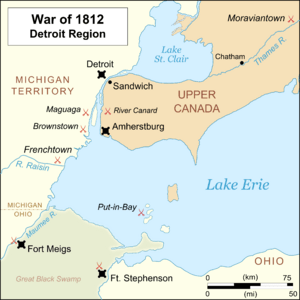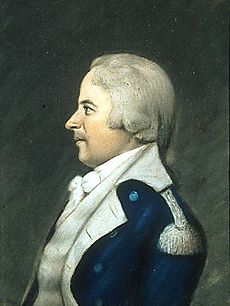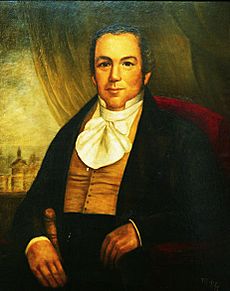Battle of Maguaga facts for kids
Quick facts for kids Battle of Maguaga |
|||||||
|---|---|---|---|---|---|---|---|
| Part of the War of 1812 | |||||||
 |
|||||||
|
|||||||
| Belligerents | |||||||
| United Kingdom Tecumseh's confederacy |
United States | ||||||
| Commanders and leaders | |||||||
| Adam Muir Tecumseh |
James Miller | ||||||
| Units involved | |||||||
|
41st Regiment Native American confederacy |
14th Infantry Regiment 4th Infantry Regiment |
||||||
| Strength | |||||||
| 75 regulars, 70 natives, 60 militia |
280 regulars, 330+ Ohio Volunteers, 60 Michigan Legionaries |
||||||
| Casualties and losses | |||||||
| 6 killed, 21 wounded, 2 captured |
18 killed, 64 wounded |
||||||
The Battle of Maguaga was a small but important fight during the War of 1812. It is also known as the Battle of Monguagon or the Battle of the Oakwoods. This battle happened near a Wyandot village called Maguaga. Today, this area is part of Riverview, Michigan.
In this battle, British soldiers, Canadian militia, and Tecumseh's Native American allies fought against a larger group of American soldiers. The American side included troops from Ohio and Michigan.
Why the Battle Happened
In the early days of the War of 1812, an American army was led by Brigadier-General William Hull. He was also the first Governor of Michigan Territory. Hull's plan was to use Detroit as a base to attack Upper Canada.
However, Hull soon changed his mind. He decided not to attack the British at Fort Amherstburg. Then, he heard that Mackinac Island had been captured by the British. Hull worried that many Native Americans would join the British forces. So, on August 3, he moved his troops back to American land.

At a place called the Miami Rapids, Captain Henry Brush's Ohio Volunteers were waiting. They had important supplies for Hull's army in Detroit. These supplies included 300 cattle and 70 packhorses loaded with flour.
On August 4, British troops led by Captain Adam Muir and Native Americans led by Tecumseh and Roundhead attacked. They defeated an American group Hull had sent to get these supplies. This fight was called the Battle of Brownstown. After this defeat, Hull sent a larger group of soldiers. This new group was led by Lieutenant-Colonel James Miller. Their mission was to bring the supplies safely back to Detroit.
The Battle Begins
At Monguagon, Miller's American forces found their way blocked. Miller had about 280 regular soldiers, over 330 Ohio Volunteers, and about 60 Michigan Legionnaires. Facing them was Adam Muir's force, with 205 British regulars, Canadian militia, and Native Americans.
As the Americans moved forward, they faced heavy gunfire. Things started to go wrong for the British side. A Canadian writer named John Richardson was there. He later wrote about how hard it was for regular British soldiers to fight in the woods. American fighters were used to rifles and could hide easily. British soldiers, with their bright red coats, were easy targets. They also didn't know much about fighting in forests.
During the battle, some British soldiers saw movement in the woods. They thought it was the enemy trying to sneak around them. So, they started shooting. But it turned out they were firing at Potawatomi warriors. These warriors were actually allies of the British, led by Chief Main Poc. The Potawatomi thought they were being attacked by Americans. Both sides shot at each other until the Potawatomi realized their mistake. They then pulled back into the woods.
Meanwhile, the American advance seemed to slow down. Muir ordered a bugler to sound the "charge" signal. In the British army, only light infantry used bugles. Other soldiers used drums. An officer from another British company heard the bugle. He thought it was the "recall" signal, meaning to fall back. So, he ordered his men to retreat. Before Muir knew it, his whole force was pulling back.
The Americans thought the British were running away from them. This gave them courage, and they moved forward, chasing an enemy they believed they had defeated. Miller's troops advanced a good distance. Then they found Muir had gathered his men and was ready to fight again. Miller, happy with his "victory," decided not to attack again.
After the Fighting
Miller's force had 18 soldiers killed and 64 wounded. Muir reported fewer losses for his side. The 41st Regiment had 3 killed, 13 wounded, and 2 missing (who were captured). The Canadian Militia had 1 killed and 2 wounded. The Native American group had 2 killed and 6 wounded.
After the battle, Colonel Miller seemed to lose his confidence. His men had dropped their backpacks to fight better. But Miller refused to go back into the woods to get them. He worried the enemy might be waiting to ambush him. He camped in a large open area. The next morning, he still refused to continue moving towards the Rapids. Miller might have been shaken by how many of his men were hurt. He also felt very sick.
What Miller didn't know was that Muir's group had already left. They had gone back to their boats and sailed to Fort Malden in Amherstburg. For two days, Miller stayed camped, ignoring orders from Hull to continue his advance. Finally, Hull realized Miller would not obey. He ordered Miller to return to Detroit.
Results of the Battle
The Battle of Monguagon had mistakes on both sides. The British accidentally retreated because of two misunderstandings. One of these could have been avoided with better training. The 41st Regiment was known for being "sharp" in drills, but they weren't trained for fighting in forests.
Colonel Miller first missed a chance to use the confusion among the British. Then, he seemed to lose his nerve completely. Even so, James Miller later had success in the War of 1812. He was even promoted to general after capturing British batteries at the Battle of Lundy's Lane. But after Monguagon, he was lucky not to face a military trial.
Miller's failure to get the supplies might have caused problems for Detroit if there had been a long siege. But Detroit surrendered to General Brock after only a few hours. So, the missing food supplies didn't matter much. The only difference was that Captain Brush's company and their supplies were not in Detroit to be captured. However, General Hull's surrender agreement included the soldiers and supplies at the Rapids. So, the British got the supplies anyway.
Monguagon was the first fight in the War of 1812 that was big enough to be called a "battle."


